- Home
- Arthur Miller
Collected Essays Page 21
Collected Essays Read online
Page 21
Broadway has been pronounced dead too many times for me to do so again, but one thing is new—its impotence before the challenge to produce new plays. It is now a secondhand merchandiser of plays from abroad or, on occasion, one of the off-Broadway theatres. That there is an audience there can be no question—the success of revivals of famous, proven works over the past decade has shown that a sizable number of people want to see straight plays on Broadway. It is the production system that has broken. It needs replacement by a new, broader vision, a rededication to essentials—the writer, the director, the actor, the audience. Whoever can bring these elements together deserves praise and gratitude, but excepting for occasional flukes, the risks have clearly grown too great now for private capital alone to manage anymore. Something not particularly novel, of course, but rather as old as theatre itself awaits us—at least partial subsidization of production by either private or public funds or a mixture of both.
Having worked in two great state-subsidized theatres—in China and Sweden, where I directed Death of a Salesman—I can testify to some of their failings as well as their virtues. Inevitably, their worst problem, I think, is bureaucracy. People nestle into state jobs and can’t be blasted out of them regardless of competency or even sobriety. (In Stockholm I had two drunks operating a hidden platform on my Salesman set, and on their cue to lower a bed they were found in the basement playing a bleary, oblivious card game. As union men they could not be fired, but one of them felt he had so humiliated himself that he resigned his position.) It is hard to see any ready solution to this dilemma. But friction arises with anything that moves, and these theatres are nevertheless often capable of work far beyond what any New York theatre can presently contemplate. Ingmar Bergman’s Peer Gynt and the Teahouse of the Beijing People’s Art Theatre, which I happened to see, were of a conceptual grandeur, a lyricism and exactitude of acting that simply cannot be achieved in our hit-and-run, semihysterical production process. They were reminders once again that every play of the European masters of the nineteenth and twentieth centuries has come out of subsidized theatres. From Brecht to Strindberg and Ibsen and reaching back to Shakespeare and the Greeks, there was a partial or complete state subsidy or, as in Elizabethan times, a noble patronage supporting the art.
But there may not necessarily be one single solution to the problem. It has to be said that in our hazardous, high-stakes gambling house called Broadway the thrill of the dice throw can be exhilarating, and in times past when productions did not yet bear killing costs the flow of new American plays was greatly admired by theatre folk in other countries. But that was then and this is now.
My own experience indicates that the best system is most probably a mixed one, with the private commercial theatre coexisting with the subsidized one. Their functions may often overlap but in general the private theatre would most likely offer entertainment while the other would be free to pursue its more difficult theatrical dreams.
The subsidized theatre can indeed settle into an institutionalized stupor if allowed to drift that way, but the British, for one, have shown that it need not, or at least not for long. In any case, if there are other alternatives than I have named to the present system, let them be heard and debated.
Theatre is not going to die. To paraphrase Carl Sandburg, there will always be the young strangers, people desperate to act, to interpret what they have seen, and now and again a writer gathering stray beams of light into a flaming focal point. Most of these now dream of the filmic media, but some of that attraction is due to the present theatre system which ignores or repels the young rather than working to open itself to them. Whole generations have passed now which have gone through the taste-forming years of youth without having seen a play, but only film. Would people want music who have never heard music? A responsible subsidized theatre would, as it does elsewhere, open the world of plays to students. If it was always at bottom an entertainment machine devised to make money and fame for a few, commercial production nevertheless did keep open a certain space for writers, directors, and actors with serious intentions and visions of a world they passionately wished to make real. No more. That whole developmental function has simply been passed along to off-Broadway and academia while commercial Broadway waits to skim off some floating drops of cream.
CONCERNING LANGUAGE
About Theater Language: Afterword to The Last Yankee
1994
I
When I began writing plays in the late thirties, something called realism was the undisputed reigning style in the American commercial theater—which was just about all the theater there was in this country. The same was more or less the case in Britain. If not a mass art, theater then could still be thought of at least as a popular one, although everyone knew—long before television—that something of its common appeal had gone out of it, and a lot of its twenties’ glamor, too. One blamed the movies, which had stolen so much of the audience and thus theater’s old dominance as a cultural influence. Notwithstanding the obvious fact that the audience was predominantly middle class, we continued to imagine that we were making plays for people of many different educational and cultural levels, a representative variety of the city and even the country. If this was never really true, there was certainly no thought of appealing to a clique of college graduates or to academics and their standards. A New York Times critic like George S. Kaufman had both feet in show business and became the most popular writer of comedies of the period, while Brooks Atkinson may have had one eye on Aristotle but understood that his readers were Americans impatient with any theatrical enterprise that required either education or patience. Outside New York there were at least the remains of the twenties’ touring wheel, theaters in many smaller cities regularly attended by quite ordinary citizens eager for last year’s Broadway hits, albeit with replacement casts. In New York, with a ticket price of 55 cents to four dollars and forty cents, one somehow took for granted that a professor might be sitting next to a housewife, a priest beside a skilled worker or perhaps a grammar-school teacher, a small or large business executive beside a student. This conception of the demotic audience, accurate or not, influenced the writing of plays directed at the commonsensical experience of everyday people. Missing were black or Asian or Hispanic faces, of course, but they were beyond the consciousness of the prevailing culture. As for production costs, even into the forties they were within reason; plays like All My Sons or Death of a Salesman, for example, cost between twenty and forty thousand to produce, a budget small enough to be raised by half a dozen modest contributors, who might lose all, with some embarrassment but reasonably little pain, or make a killing.
Radicals—people like myself, trying to convince ourselves that we were carrying on the age-old tradition of theater as a civic art rather than a purely commercial one—were in a conflict; to attract even the fitful interest of a Broadway producer, and subsequently to engage the audience, we had to bow to realism, even if the poetic forms were what we really admired or at least wished to explore. An Expressionist like the German Ernst Toller, for example, would not have been read past his sixth page by a Broadway producer or, for that matter, one in London. Among the playwrights one thinks of as important, not one was—or is now—welcome in the commercial theater. Not Chekhov, not Ibsen, not Hauptmann, not Pirandello, Strindberg, Turgenev—not even Shaw. To so much as think of performing a Beckett play like Waiting for Godot in the general proximity of Broadway a cast of movie stars and a short run are essential—Lincoln Center pulled it off in 1988—and things were probably a bit worse half a century ago. One need only read O’Neill’s letters of complaint at the “showshop” of Broadway and the narrow compass of the American audience’s imagination—or in Britain, Shaw’s ridicule of his countrymen’s provincialism—to understand the problem; for some mysterious reason the Anglo-Saxon culture regarded theater as an entertainment first and last, an art of escape with none of the Continental or Russian interest in moral and philoso
phical opportunities or obligations. Very occasionally in America there was an Adding Machine by the young Elmer Rice, but such a breakout from conventional realism was rare enough to be brought up in conversation for years after, like a calf born with five legs. The English-language theater was pridefully commercial, a profit-making enterprise which wed it to a form whose surfaces of familiar reality would be universally recognized. Captain Shotover’s outcry, “I like to know where I am!” could have been sewn to the flag of this theater. Only musicals had the happy license to stretch reality, at least to some extent. But for straight plays, even satire was too strange to prosper; George Kaufman defined satire as what closes on Saturday night.
The point here is that what we think of as “straight realism” was tiresome half a century ago, indeed longer ago than that, but it was accepted by the audiences and almost all the reviewers as a reflection of life. Nonetheless, it should be remembered that realism has emerged at various moments to very capably express the essence of an era. At a time when “experimental” is all the virtue a play needs in order to gain serious consideration, it is not a bad idea to confess that an extraordinarily few such researches have achieved any kind of enduring life. It is not quite enough to know how to escape; one has also to think of arriving somewhere.
In the thirties, probably the single exception—at least that I was aware of—to realism’s domination was the WPA’s Living Newspaper, the one formal innovation of American theater. An epic in more or less presentational form, written like movies by groups of writers, rather than individually, it dealt in an overtly exuberant spirit with social issues like public ownership of electrical power, labor unions, agriculture, and medicine, and was extremely popular. Significantly, the WPA was government-subsidized, and did not have to make a profit. Using unemployed actors, designers, technicians, a show could call upon large casts and elaborate scenery and production elements. And the ticket was low-priced. The WPA could send Orson Welles, for example, into Harlem storefronts with a big cast playing Doctor Faustus, charging a quarter a seat. But theater-for-profit was hardly affected by what might be called this epic-populist approach—it was simply too expensive to produce.
I mention these mundane matters because they profoundly affect style in the theater, which, like politics, is always the art of the possible.
There were at least a dozen playwrights regularly feeding the commercial theater in the years before World War II, and all but perhaps Odets and Hellman would have pridefully declared that their sole purpose was to entertain. Those playwrights were sophisticated and no doubt knew all about the Continental theater tradition, and its aspiring to the philosophical condition, something like that of the Greeks or, in a different way, the Elizabethans. The Theater Guild, for one, had been started in the twenties in part to bring that kind of theater to America, the theater of Pirandello, Schnitzler, Ibsen, and Strindberg.
In the thirties, one American styled himself a political revolutionary, and that was Clifford Odets. O’Neill, of course, had been the aesthetic rebel but his socialism was private rather than informing his plays, although The Hairy Ape is surely an anticapitalist work. It was his formal experiments and tragic mood that set him apart. O’Neill was a totally isolated phenomenon in the Broadway theater as a maker and user of new and old theatrical forms.
Odets, on the other hand, while describing himself as “a man of the Left,” was, with the possible exception of his first play, Waiting for Lefty, no innovator where form was concerned. He attempted a poetic realism but it was still trying to represent real people in actual social relationships. And this was perhaps inevitable given his actor’s temperament as well as his Marxist commitment; he had the revolutionary’s eye on the great public, on the reconstitution of power once a failed capitalism had been brought down—for such was the Marxist and non-Marxist Left position on the proper moral obligation of the artist. But by temperament he was a poet seeking words that would lift him into a takeoff, regardless of his realist political commitments. O’Neill, on the other hand, was not the revolutionary but the rebel with a despairing anarchism in his heart. If he glimpsed any salvation, it was not to arrive in a more benign reconstitution of political power but in the tragic cleansing of the life-lie permanently ensconced in the human condition. Since he took no responsibility in theory for a new and better policy to take the place of the corrupted present one, he was free to explore all sorts of theatrical means by which to set forth the situation of the damned. Moreover, if O’Neill wanted his plays to register, and he surely did, they need not be popular to justify his having written them, for he was hunting the sounding whale of ultimate meaning, and he expected to suffer for it; oppositely, a critical or box-office failure for Odets meant rejection of a very personal kind, a spit in the eye by an ungrateful, self-satisfied bourgeois society. A failed play for Odets was a denial of what he was owed, for he was chasing the public no differently from his bourgeois nonrevolutionary contemporaries. O’Neill could say, and he did, that he was not interested in relations between men, but between Man and God. For America, in his view, was damned and if there were a few individuals who behaved justly and well, it was not because they belonged to a particular social class or held a generous or unselfish political viewpoint, but by virtue of a grace whose source is beyond definition.
II
The realism of Broadway—and the Strand and the Boulevard theater of France—was detested by the would-be poetic dramatists of my generation, just as it had always been since it came into vogue in the nineteenth century. What did this realism really come down to? A play representing real rather than symbolic or metaphysical persons and situations, its main virtue verisimilitude, with no revolutionary implications for society or even a symbolic statement of some general truth. Quite simply, conventional realism was conventional because it implicitly supported the conventions of society, but it could just as easily do something quite different, or so it seemed to me. Nevertheless, we thought it the perfect style for an unchallenging, simpleminded, linear middle-class conformist view of life. What I found confusing at the time, however, was that not so very long before, the name “realism” had been applied to the revolutionary style of playwrights like Ibsen, Chekhov, and quite frequently Strindberg, writers whose thrust was in opposition to the bourgeois status quo and the hypocrisies on which it stood, or, in Chekhov’s case, the futilities of the Czarist system.
My own first playwriting attempt was purely mimetic, a realistic play about my own family. It won me some prizes and productions, but, interestingly, I turned at once to a stylized treatment of life in a gigantic prison, modeled on Jackson State Penitentiary in Michigan—near Ann Arbor, where I was in school—the largest prison in the United States, which I had visited over weekends with a friend who was its lone psychologist. The theme of that play was that prisons existed to make desperate workingmen insane. There was a chorus of sane prisoners chanting from a high overpass above the stage, and a counterchorus of the insane trying to draw the other into their ranks. It was inevitable that I had to confront the problem of dramatic language, for it was impossible to engage so vast a human disaster with speech born in a warm kitchen. I gradually came to wonder if the essential pressure toward poetic dramatic language—if not of stylization itself—came from the inclusion of society as a major element in the play’s story or vision. Manifestly, prose realism was the language of the individual and private life, poetry the language of man in crowds, in society. Put another way, prose is the language of family relations; it is the inclusion of the larger world beyond that naturally opens a play to the poetic.
But I wanted to succeed, I wanted to emerge and grip an audience. Minds might be illuminated by speeches thrown at them but it was by being moved that one was changed. And so the problem was that our audiences were trained, as it were, in a pawky realism and were turned off by stylistic novelty, by “art.” How to find a style that would at one and the same time deeply engage an American audienc
e, which insisted on a recognizable reality of characters, locales, and themes, while opening the stage to considerations of public morality and the mythic social fates—in short, the invisible?
Of course, this was not my preoccupation alone. I doubt there was ever a time when there was so much discussion about form and style. T. S. Eliot was writing his verse plays, and Auden and Isherwood theirs; the poetic mimesis of Sean O’Casey was most popular; and W. B. Yeats’s dialogue was studied, if not very often produced. The impulse to poetry reached into the ex-newspaperman and realistic writer Maxwell Anderson, whose attempts to imitate Elizabethan prosody with contemporary characters and social themes were widely celebrated, as curious by some, as moving experiences by others.
To be just to Odets, it was he who challenged the Broadway theater’s addiction to verisimilitude by his idiosyncratic dialogue. And he was surely the first American playwright to be celebrated—and more wildly and lavishly than any other before him—for his writing style. For younger writers such as myself, Odets for a couple of years was the trailblazer; he was bringing the suffering of the Great Depression onto the Broadway stage and making audiences listen. If he had not solved the problem of a contemporary American style, he had dared to invent an often wildly stylized stage speech. But I suppose that since his characters lacked elegance or strangeness, were, in fact, the very exemplars of realistic theater, Odets was called a realist—indeed, a kind of reporter of Jewish life in the Bronx. I may not have lived in the Bronx but the speech of Brooklyn Jews certainly bore no resemblance to that of Odets’s characters.
CARP [in Golden Boy]: I’m superdisgusted with you! . . . A man hits his wife and it’s the first step to fascism! Look in the papers! On every side the clouds of war! . . . Ask yourself a pertinent remark; could a boy make a living playing this instrument [a violin] in our competitive civilization today?

 A View From the Bridge: A Play in Two Acts
A View From the Bridge: A Play in Two Acts Broken Glass
Broken Glass Death of a Salesman
Death of a Salesman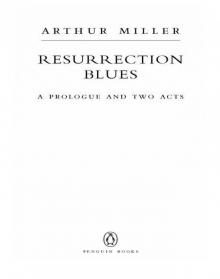 Resurrection Blues
Resurrection Blues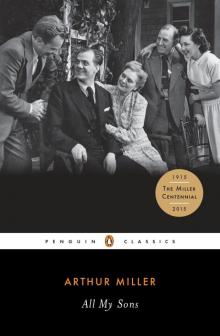 All My Sons
All My Sons The Man Who Had All the Luck
The Man Who Had All the Luck Presence: Stories
Presence: Stories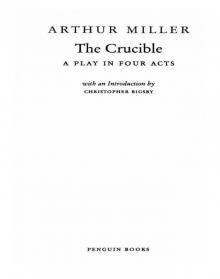 The Crucible
The Crucible Collected Essays
Collected Essays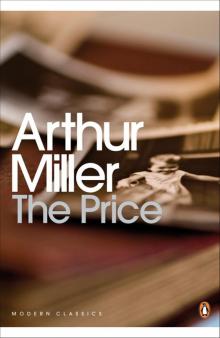 The Price
The Price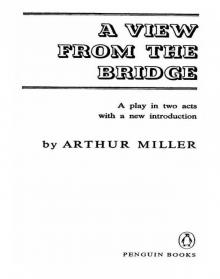 A View from the Bridge
A View from the Bridge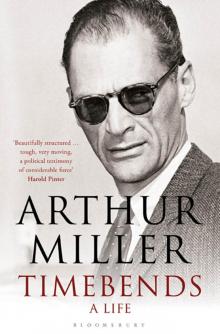 Timebends
Timebends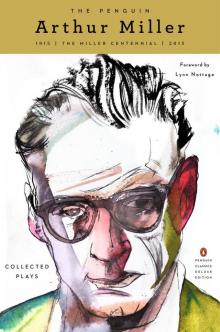 The Penguin Arthur Miller
The Penguin Arthur Miller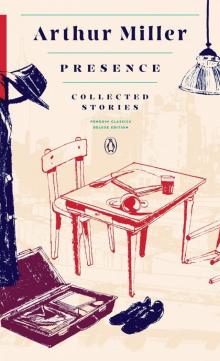 Presence
Presence